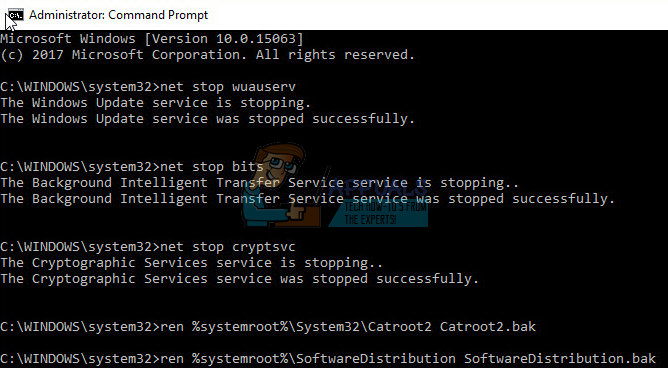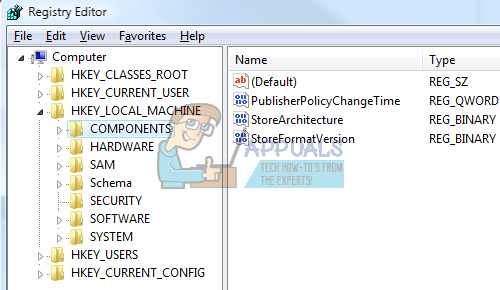Fix: An unexpected error has occurred. The troubleshooting wizard can’t continue.
Windows has several built-in troubleshooters which can really assist with some of the most common issues you might be faced up against. The troubleshooter might not always solve the problem you were experiencing at the moment but it will display what went wrong and you can narrow down your search for the right answer.
Windows 10 troubleshooters can be located in the Settings app under the Update & Security section. For example, if you are experiencing issues with your Internet connection, you can try running the Internet Connections troubleshooter.
However, sometimes the troubleshooter simply won’t start and it will display this error message: “An Unexpected Error Has Occurred. The Troubleshooting Wizard Can’t Continue.” This can be quite annoying, especially if you were trying to solve a problem that has been bugging you for a while. Follow the solutions below in order to find out how to solve this issue.
Solution 1: If the Problem Occurred After an Update
If the solution you were having occurred after you have performed an update or after Windows installed it on its own, you might be able to solve the issue simply by resetting your Windows Update components, as this worked for plenty of users who were struggling with the exact same problem:
- Let’s proceed with the solution by killing the following services which are the core services related to Windows Update: Background Intelligent Transfer, Windows Update, and Cryptographic Services. Disabling them before we start is crucial if you want the remainder of the steps to perform smoothly.
- Search for “Command Prompt”, right-click on it, and select the “Run as administrator” option. Copy and paste the following commands and make sure you click Enter after each one.
net stop bits
net stop wuauserv
net stop appidsvc
net stop cryptsvc

- After this, you will have to delete some files which should be deleted if you want to continue with resetting the update components. This is also done via Command Prompt with administrative privileges.
Del “%ALLUSERSPROFILE%\Application Data\Microsoft\Network\Downloader\qmgr*.dat”
- The following step can be skipped if this is not last resort. This step is considered to be the aggressive approach but it will definitely reset your updating process from its very core. So we can recommend that you try this out. It has been suggested by a lot of people on online forums.
- Change the name of the SoftwareDistribution and catroot2 folders. In order to do this, at an administrative command prompt, copy and paste the following commands and click Enter after copying each one.
Ren %systemroot%\SoftwareDistribution SoftwareDistribution.bak
Ren %systemroot%\system32\catroot2 catroot2.bak

- The following commands will help us reset the BITS (Background Intelligence Transfer Service) and the wuauserv (Windows Update Service) to their default security descriptors. Make sure you don’t modify the commands below so it’s for the best if you simply copy them.
exe sdset bits D:(A;;CCLCSWRPWPDTLOCRRC;;;SY)(A;;CCDCLCSWRPWPDTLOCRSDRCWDWO;;;BA)(A;;CCLCSWLOCRRC;;;AU)(A;;CCLCSWRPWPDTLOCRRC;;;PU)
exe sdset wuauserv D:(A;;CCLCSWRPWPDTLOCRRC;;;SY)(A;;CCDCLCSWRPWPDTLOCRSDRCWDWO;;;BA)(A;;CCLCSWLOCRRC;;;AU)(A;;CCLCSWRPWPDTLOCRRC;;;PU)
- Let’s navigate back to the System32 folder in order to proceed with the solution at hand.
cd /d %windir%\system32
- Since we have completely reset the BITS service, we will need to reregister all of the files necessary for the service to run and operate smoothly. However, each of the files requires a new command in order to make it reregister itself so the process may end up being lengthier than what you are used to. Copy the commands one by one and make sure you don’t leave out any of them. Here is a list of files which need to be reregistered along with the corresponding commands next to them.
- Some files may have been left behind after these processes so we are going to look for them in this step. Open the Registry Editor by typing “regedit” in either the search bar or the Run dialog box. Navigate to the following key in Registry Editor:
HKEY_LOCAL_MACHINE\COMPONENTS

- Click on the Components key and check the right side of the window for the following keys. Delete them all if you locate any of them.
PendingXmlIdentifier
NextQueueEntryIndex
AdvancedInstallersNeedResolving
- The next thing we are going to do is reset Winsock by copying and pasting the following command back into the administrative Command Prompt:
netsh winsock reset

- If you are running Windows 7, 8, 8.1, or 10, at a command prompt, copy the following command, and tap the Enter key:
netsh winhttp reset proxy
- If all of the steps above have gone through painlessly, you can now restart the services you killed in the very first step by using the commands below.
net start bits
net start wuauserv
net start appidsvc
net start cryptsvc
- Restart your computer after following through with all of the steps which are listed.
Solution 2: Use the Chkdsk Utility
Some users claim that using the chkdsk utility helped fixed their issue almost immediately as these errors sometimes occur if the hard disk files have gone corrupt or similar. The process is quite easy but it may take a while for the tool to finish.
From Command Prompt
- Turn on your computer and log into Windows 10
- Press the Windows key in order to open the Start Menu, select the search button or start typing immediately, and type in “cmd”

- Select “Command Prompt” which should be the first result, right-click on it, and select the Run as administrator option.
- When Command Prompt launches, type in the following command:
- chkdsk C: /f /r /x

- The parameters for this command can be explained like this:
- /f option will try to fix any found errors
- /r option will search for bad sectors and recover any readable information
- /x option will force the drive you’re about to check to be dismounted before the tool begins a scan
- If the C: drive is in use, type Y to run a scan at your PC’s next restart. If so, you should exit Command Prompt and restart the computer in order to make the scan run at the next startup.
From My Computer
- Turn on your computer and log into Windows 10.
- Double-click on This PC (My Computer) in order to open it and right-click on the drive you would like to run a check on. Select the Properties option and navigate to the Tools tab.
- Navigate to the Error checking section and select the Check option.

- If you see the following message, click Scan drive to begin the scan:
- You don’t need to scan this drive
We haven’t found any errors on this drive. You can still scan the drive for errors if you want. - You can keep using you computer during the scan. If any errors are found, you can decide if you want to fix them immediately. Depending on the results of this scan, the tool will form the results:
- If no errors occur on your drive, you’ll see this message:Your drive was successfully scanned
Windows successfully scanned the drive. No errors were found.
- If errors occur on your drive, you’ll see this message instead:
Restart your computer to repair file system. You can restart right away or schedule the error fixing on next restart.
Solution 3: Repair .NET Framework
This particular method may sound strange but it appears that a recent installation of Microsoft .NET Framework may be a cause for this issue. If this is indeed the case, the problem should be able to solve itself in a couple of minutes.
- Open your Windows Settings and navigate to the Apps section if you are using Windows 10.
- Open Control Panel >> Programs and Features, if you are using an older Windows OS.

- Locate .NET Framework on the list of your installed programs list and click on “Uninstall/Change”.
- A window should open with several choices and you should be able to choose the Repair option instead of remove.

- The wizard will start to repair the installation on .NET Framework and you should now be able to run any troubleshooter without problems.
- If this doesn’t work, you can always try to simply reinstall .NET Framework.
Solution 4: Make Sure Some of the Essential Services are Running
Some of the services essential for the troubleshooting wizards are:
Diagnostic Service Host service
Diagnostic System Host service
Diagnostic Policy service
Without these services, the troubleshooter has no chance of starting so you should really check if these services are configured to run at all.
- If you are using a version of Windows older than Windows 10, the easiest way for you to access the services running on your PC is clicking on the Start button and navigating to the Run dialog box.
- Type “services.msc” in the dialog box and wait for the list of services to open.

- If you are using Windows 10, you can also access Services by using the Ctrl + Shift + Esc key combination in order to bring up Task Manager.
- Navigate to the Services tab in Task Manager and click on Open Services at the bottom of its windows, next to the gears icon.
After you have successfully open Services, follow the instructions below.
- Locate the Diagnostic Service Host service by clicking on the Name column in order to sort the services in an alphabetical order.
- Right-click on the Diagnostic Service Host service and click on Properties.
- Navigate to the Startup type and set it to Automatic (Delayed Start).

- If the service is not running, you will be able to click on Start just under the Service status.
The service should start now and you won’t have any problems dealing with it in the future. However, you may receive the following error message when you click on Start:
“Windows could not start the Diagnostic Service Host service on Local Computer. Error 1079: The account specified for this service differs from the account specified for other services running in the same process.”
If this occurs, follow the instructions below to fix it.
- Follow the steps 1-4 from the instructions below in order to open service’s properties.
- Navigate to the Log On tab and click on the Browser… button.
- Under the “Enter the object name to select” box, type in your computer’s name and click on Check Names and wait for the name to become authenticated.

- Click OK when you are done and type in the administrator password in the Password box when you are prompted with it.
- Click OK and close this window.
- Navigate back to Diagnostic Service Host service’s properties and click Start.
- Close everything and check to see if the service is still running.
Note: If you still notice certain issues, open Services again by following the instructions above and repeat the same process for services named Remote Diagnostic System Host service
and Diagnostic Policy service. Make sure there are started and that their startup type is set on Automatic.